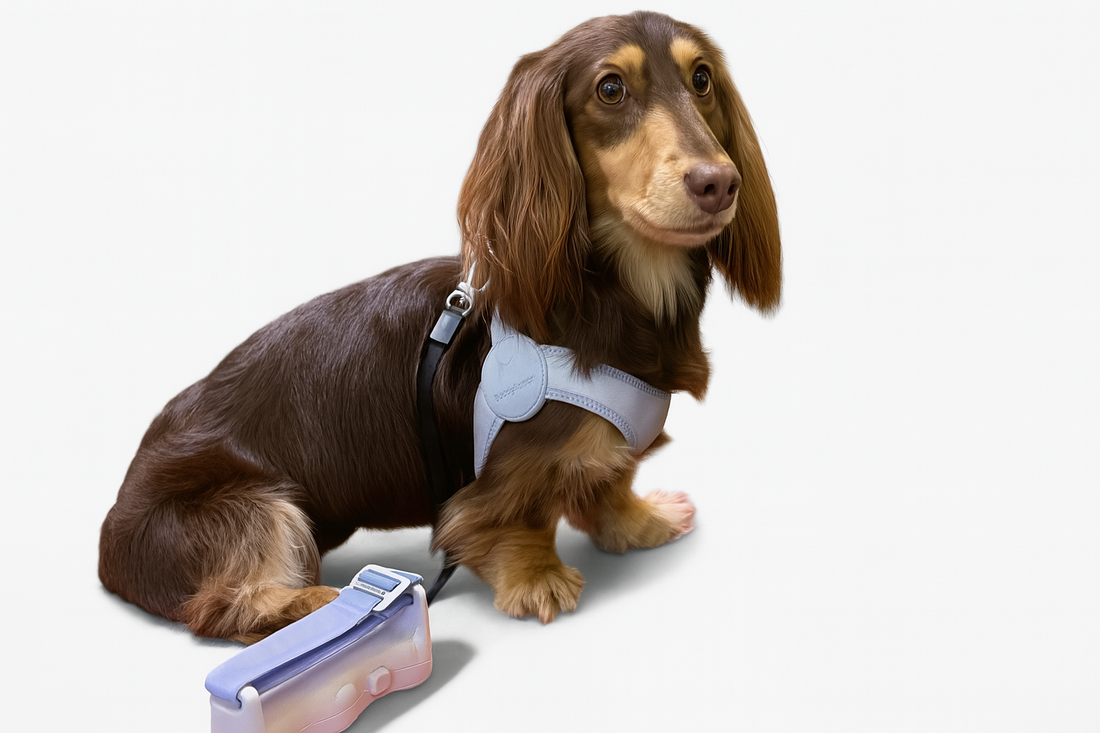
How To Fit a Harness for a Dachshund’s Body Shape: Stop Pulling and Protect Their Back
Compartir
Does your Dachshund wriggle out of every harness or pull like a sled dog? You’re not alone. With their long backs and deep chests, finding the perfect fit can feel impossible. But with the right harness and a few simple tweaks, you can keep your Doxie safe, comfy, and ready for tail-wagging adventures. 🐾
Dachshunds are small dogs with big personalities. They’re bold, curious, and surprisingly determined—especially when something exciting catches their nose. But their unique body shape—a deep chest paired with a long, delicate back—means a poorly fitted harness can do more than cause discomfort; it can actually put strain on their spine and worsen back problems like IVDD.
That’s why learning how to fit a harness for a Dachshund’s body shape matters. The right fit doesn’t just stop pulling—it protects their health and keeps every walk frustration-free. With the right approach, you can prevent slipping, chafing, and back strain while giving your pup the secure, cozy fit they need to strut their stuff. Let’s break it down step-by-step!
Listen our latest episode about this blog on Spotify:
1. Measure Your Dachshund’s Chest and Neck First
Getting the perfect harness fit starts with accurate measurements—no guessing! Dachshunds have deep chests and narrow necks, so standard sizing often doesn’t work. Use a soft, flexible tape measure and wrap it snugly (but not tightly) around the widest part of your Dachshund’s chest, just behind their front legs. Then, measure the base of their neck where a collar would naturally sit.
Write these numbers down and compare them to the harness manufacturer’s sizing chart. If your Doxie falls between sizes, choose the larger one for comfort and adjust the straps. A poorly fitted harness can slip, chafe, or even press into sensitive areas, which may lead to discomfort or spinal strain.
Once you receive the harness, try it on and observe how it sits on your dog’s body. The chest piece should rest flat and secure, without gaps or pinching. A properly measured harness won’t twist, ride up, or limit your Dachshund’s range of motion.
🎁 Pro Tip: Check out our SoftFit Dachshund Harness and Leash – Ultra-Comfy No-Pull Design – it’s designed specifically for long-backed pups, with sizing that perfectly matches their unique proportions for a safe, comfy fit.
2. Choose a Low-Front Design for IVDD Safety
Dachshunds are prone to intervertebral disc disease (IVDD), so harness design matters as much as fit. A well-chosen harness reduces strain on their neck and back, helping prevent injuries. Look for a Y-shaped or vest-style harness that sits low on the chest and distributes pressure evenly across the torso. This design keeps weight off the neck and prevents stress on the spine.
Avoid harnesses with horizontal straps across the shoulders or those that pull up around the neck. These can limit natural movement or cause unwanted pressure on sensitive areas. Instead, choose a style that allows your Doxie to walk comfortably while staying supported.
When trying on a harness, check how it moves when your dog walks or pulls slightly. The harness should stay in place without shifting, rubbing, or putting pressure on the throat. A proper low-front fit not only protects their back but also gives you more control during walks without the risk of injury.
🎁 Pro Tip: Try the WagFree No Pull Doxie Harness and Leash Set– its ergonomic, IVDD-friendly design ensures safer, more comfortable walks while giving you better handling power.
3. Adjust Each Strap for a Snug but Comfy Fit
Even the best harness won’t work if it isn’t adjusted properly. After putting the harness on your Dachshund, tighten the straps until they’re snug, but never restrictive. A good rule of thumb is the “two-finger test”: you should be able to slide two fingers easily between the strap and your dog’s fur. This ensures the harness is secure but still comfortable.
Pay special attention to the chest and neck straps. If they’re too loose, your Doxie might slip out—especially during an excited sprint after a squirrel. If they’re too tight, you risk rubbing, restricted movement, or pressure on the spine.
Adjust each strap evenly to keep the harness balanced and sitting in the correct position. Watch how your Dachshund moves during the first few walks and recheck the fit. Some harness materials stretch slightly over time, so a quick adjustment every few weeks helps maintain the perfect fit.
Taking these small steps ensures the harness supports your dog without restricting their natural gait or causing discomfort. And a comfortable harness means happier, safer walks for both of you.
4. Check for Rubbing or Hair Loss Spots
Even with careful measuring and strap adjustments, it’s important to check for signs of chafing or irritation. Dachshunds have sensitive skin, especially around their armpits, chest, and belly, where harness straps sit. After a walk, look for redness, hair loss, or sore spots. If you see any of these signs, it’s time to adjust or reconsider the harness.
To reduce rubbing, you can slightly loosen the straps, add a padded layer, or switch to a softer harness material. Some dogs may even benefit from fleece-lined harnesses for extra comfort. Remember, a properly fitted harness should sit securely without digging in or leaving marks.
You should also inspect your Doxie’s harness regularly. Dirt, sweat, or trapped hair can cause friction over time, increasing the risk of irritation. A quick wipe-down or wash can help keep the harness soft and safe for daily use.
Paying attention to your Dachshund’s body language is key. If they seem uncomfortable or resist putting on their harness, it might be a sign that something’s not right with the fit or material. Adjusting early helps prevent long-term skin problems and keeps your dog comfortable. 🐶
5. Recheck the Fit Every Few Weeks
Your Dachshund’s body isn’t static—seasonal coat changes, slight weight fluctuations, or even washing the harness can affect the fit. That’s why it’s important to recheck the harness regularly. Every few weeks, measure your dog’s chest and neck again and confirm that the harness still sits correctly.
If the straps seem too loose, tighten them slightly to prevent slipping. If they’re too tight, loosen them to avoid rubbing or pinching. Regular adjustments ensure that your Dachshund remains safe and comfortable, especially as they grow or age.
It’s also a good habit to check the hardware and stitching. Worn buckles or stretched-out straps can compromise safety. Replacing or upgrading the harness when needed is far better than risking a sudden failure during a walk.
This small routine protects your Dachshund’s back, keeps them secure, and guarantees stress-free walks for both of you. Plus, rechecking the fit takes less than a minute—but it can prevent major discomfort for your pup and give you peace of mind.
Conclusion
Fitting a harness for a Dachshund’s body shape isn’t just about comfort—it’s about safety. With their long backs and deep chests, a proper fit prevents pulling, protects the spine, and turns walks into joyful bonding time instead of stressful tug-of-war.
By measuring carefully, choosing the right harness design, and making small adjustments, you’ll give your Doxie the support they need for a lifetime of safe, happy adventures. Stay consistent, check the fit often, and you’ll have a confident, comfortable pup who’s ready to strut their stuff on every walk.
Related Articles
Dachshund Obedience Secrets: Get Your Stubborn Pup to Listen Without Being Harsh
No More Back Problems: 5 Ways to Protect Your Dachshund’s Spine and Prevent IVDD
5 Surprising Benefits of Entertainment in Your Dachshund’s Routine
👉 For more expert Dachshund care tips, visit our blog.
